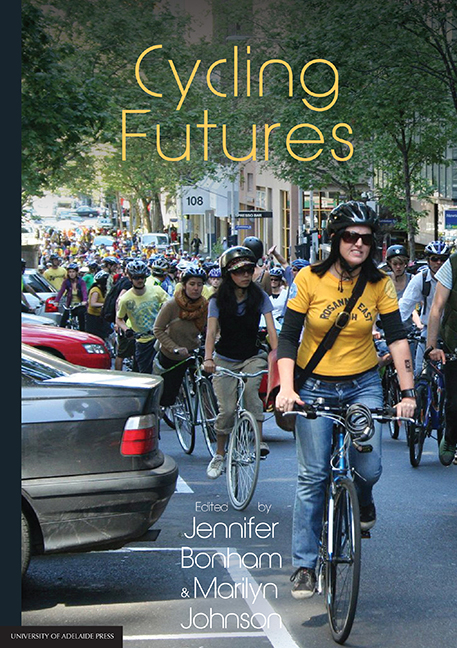Book contents
- Frontmatter
- Contents
- Preface
- Editors
- Contributors
- PART I Current challenges
- 1 Cycling: Bringing the future into the present
- 2 A glimpse at Australia's cycling history
- 3 Health benefits of cycling
- 4 An epidemiological profile of cycling injury in Australia and New Zealand
- 5 Faster than the speed of bikes
- 6 Economics of everyday cycling and cycling facilities
- 7 Cycling and sustainable transport
- 8 Cycle touring
- PART II Strategies for change
4 - An epidemiological profile of cycling injury in Australia and New Zealand
from PART I - Current challenges
Published online by Cambridge University Press: 25 July 2017
- Frontmatter
- Contents
- Preface
- Editors
- Contributors
- PART I Current challenges
- 1 Cycling: Bringing the future into the present
- 2 A glimpse at Australia's cycling history
- 3 Health benefits of cycling
- 4 An epidemiological profile of cycling injury in Australia and New Zealand
- 5 Faster than the speed of bikes
- 6 Economics of everyday cycling and cycling facilities
- 7 Cycling and sustainable transport
- 8 Cycle touring
- PART II Strategies for change
Summary
Introduction
This chapter aims to provide information about cycling crashes and injury patterns in Australia and New Zealand [NZ]. Hopefully, it will soon be outdated! Initiatives to promote cycling, and to improve cycling safety, are already being implemented across Australia and New Zealand. If all goes well, such initiatives could result in more people cycling, and fewer people being injured while cycling (Organisation for Economic Co-operation and Development [OECD]/International Transport Forum [ITF], 2013).
The chapter focuses on cycling on paths and roads because most relevant policy aims to increase cycling for transport, which occurs mostly on paths and roads. Much cycling for recreation and/or fitness also occurs on paths and roads. Cycling on mountain-bike trails, in BMX parks, and in velodromes is not in focus in this chapter. Nonetheless, injuries sustained during such cycling may be included in some data presented. Depending on its source, data may include a range of cycling activities (for example, trekking, travelling to the shops) which may have different risk profiles. There is no administrative data available in which these activities are separated. However, police-reported data, as opposed to hospitalisation data, is more likely to exclude some activities such as riding in off-road settings.
Some cycling advocates shun discussion of cycling crashes and injuries because it may contribute to a perception that cycling is unsafe, and so discourage people from cycling. Indeed, the perceived danger has been shown to be a key deterrent to cycling in Australia (Daley, Rissel, & Lloyd, 2007; Garrard, Crawford, & Hakman, 2006) and New Zealand (Mackie, 2009). However, it is important to understand the patterns and causes of cycling injury so that injury risk can be minimised.
Moreover, as Chris Rissel (Chapter Three, this volume) points out, it is important to recognise that on average people who ride bicycles have been found to have a lower all-cause mortality risk than those who do not, despite any risk of injury associated with cycling (China: Matthews et al., 2007; Denmark: Andersen, Schnohr, Schroll, & Hein, 2000; Finland: Hu et al., 2004). While these results are specific to the cycling environments in which they were observed, which may be more advanced than our own, they suggest that it is possible to create an environment in which cycling is health-enhancing. Increased cycling safety potentially increases the health benefits of cycling.
- Type
- Chapter
- Information
- Cycling Futures , pp. 63 - 88Publisher: The University of Adelaide PressPrint publication year: 2015



